UAV
BE your own CAMERA CREW
Robotic implications and emerging technologies have always been a fascination of mine, and my university career has lead me to want to dive into these potentials usually by obtaining a new device or creating an account on a platform and just using them. Over the years at the University of Wollongong, I’ve created some digital artefacts, media art and written countless blog posts that have attributed to a creative content portfolio that will serve as a resume moving into the digital generation, lead by us in communications and digital media. This aggregated content curation has lead me to drone technology and how this emerging technology will be something this degree and certainly its graduates will have to become aware of as a tool to capture aerial images and video. I’ve been focused on the devices for about 2 years now, ranging from theoretical research and skillsets within ethical privacy, e-waste, production and consumption in the Asian Pacific, commercial and non-commercial use, agricultural implications, aesthetic filming and editing as well as launching a start-up within iAccelerate fuelled by UOW pitch 2016 whereby I’ve designed, built and implemented a drone device in collaboration with the RMS.
What I intend to do for this kind of research is something perhaps down the aesthetic road, whilst still defining my expertise and encouraging others to do so. I was to understand and field test the options that “off-the-shelf” commercial drones offer filmmakers and creatives, essentially out of the box ready to fly. Collision avoidance, active tracking and smart landing features are all components that drone manufacturers have to have as a core to their product if they’re to compete in the market today. These devices are a flying personal camera crew, and I want to create a video that captures myself as the subject that’s filmed by me. The edit is then done by me and my skills in two fields are already being tested and improved. That the act of creating and learning from failure still have more physical work showcase potential than ever before, we now have an evolutionary showreel to showcase what we’d describe in a written resume’ as “flexible, diverse and hard working”. Inevitably, this content creation goes back into my portfolio online and hopefully as media professionals scroll through the years, areas of improvement are evident.
For this digital artefact titled, “Be your Own Camera Crew”, I want to create a series of, or one video, to capture the skills I’ve learnt over the years of university attendance and the skillset from that, and create a visual showcase of this device potential for content creators like us who are trying to create jobs that perhaps aren’t even open for positions yet. The processes of editing, planning shots and ultimately creating a start to finish product that can then be used for a workplace portfolio is something i’d be interested in exploring. The drone I will be using is a product made by DJI, one of the world’s leading manufacturers in quadcopter technology, utilizing what’s called “active track”. This feature allows its user to click and drag a virtual box around a subject on live view from the drone on a smartphone, to then become the focus point of the shot. Once the subject is recognised and focused on, piloting the drone becomes automatic, without the use of the controller or even any piloting gestures. This means the person creating the work doesn’t have to worry about missing a particular moment in the filming process as the drone stays fixed on them. The type of video I would like to create would be something visually aesthetic as well as something with motion. The editing is then done with free software that comes with both personal laptops, in my case iMovie, or at the University. Lastly, the platform YouTube, allows this to be publically available for anyone with an internet upload connection. This will allow feedback for critic, as well as the convenience of a link to embed in future career initiation talks and applications.
I will be tangling with the week 5 topic of “The Object” and the autonomous function found on commercial quadcopters today. With some research, I’ve discovered that I’m not alone in my thinking that drones could serve a real world place in terms of providing accessibility to social, educational and creative disciplines, as theorist Utkarsh Mittal conveniently states that drones will provide new opportunities for content creation and research, users may expect drones to be part of the technology resources available. I use this example broadly, but some specific examples that I’ve been exposed to are the library at the University of Wollongong. The ‘maker-space’ will encourage emerging technologies and new devices on offer for students to complete projects that require an extra layer of physicality or aesthetic. These include drones, 3D printers and virtual reality, all available within a University library, which means the integration of these devices are already being encouraged as academic resources.
In my project, I want to contribute to this discussion from the viewpoint of a creative content creator.The unmanned aerial vehicles (UAVs) are linked to all kinds of prejudice and harsh criticisms about privacy, hostility and the unknown realm that is autonomous robotics. My intention is to explore the latter of these categories, and unlock what it means to aspiring media professionals like myself, when devices we use to conduct research and perform our creative tasks suddenly are able to do this without piloting and without supervision.
Stay tuned.
Personal Devices in Public Space
This week I’m going to focus on the use of personal devices and capturing moments within photography and the ethics regarding usage both personally and commercially. I’ve decided to attack this from a slightly different angle and apply it to research I’ve been carrying out over the past year and a half; drone footage.
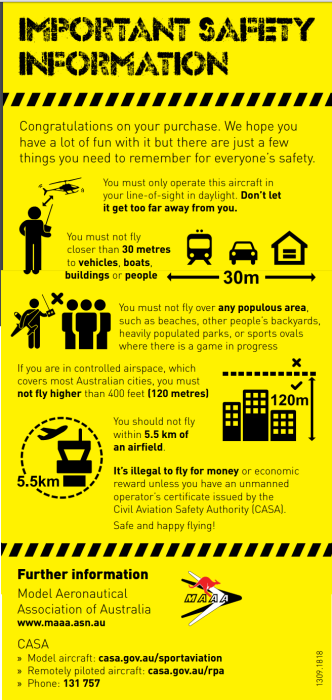 (http://edge.alluremedia.com.au/m/g/2015/12/casa1.png)
(http://edge.alluremedia.com.au/m/g/2015/12/casa1.png)
This pamphlet is something users get when purchasing a commercial drone aircraft as a guideline to keep the public safe. This is a useful tool for safety and generalised public welfare but this area of public device usage in Australia is still a huge grey area. When looking at “Arts + Law Information Sheet: Street Photographers RIght” is refers back to a commerical gain for the individual rather than a privacy statement, thus ”
“The regulation of photos is primarily directed to commercial photography and disruptive photographic activities.”
With this in mind I went to a soccer field oval so that I could hover over the empty public space and yet still grab the photographs of my close friend Sonny Nguyen skating around an empty car-park. What was interesting however was his girlfriend that was on her smart phone enabling this to happen. As i would pilot the drone, she had to press stop and start recording to which I captured below:
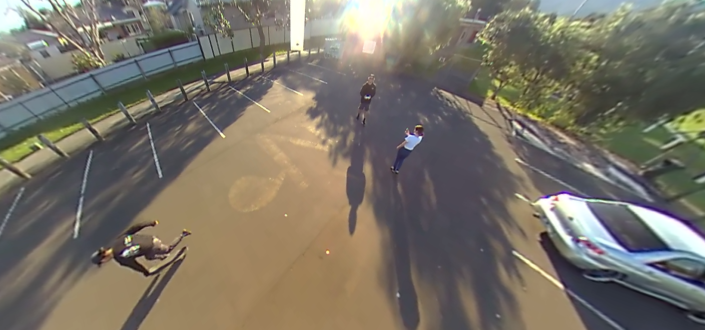
I integrated these brochure policies as well as a risk assessment of the area in terms of trees, buildings and population numbers. I then had a duty of care to those that were in attendance with me.
Devices such as this drone I’ve custom built and integrated an external camera, need devices we use like smart phones and wireless connectivity to create the content produced with these tools like 360 degree video available today! I think an incredible aesthetic is captured in this photo that creates a sense of narrative into whats happening. Multiple producers with the subject able to concentrate on the task performed.
Head over to my YouTube Channel to see the finished video!
Custom Drone Build w/ 360 Camera
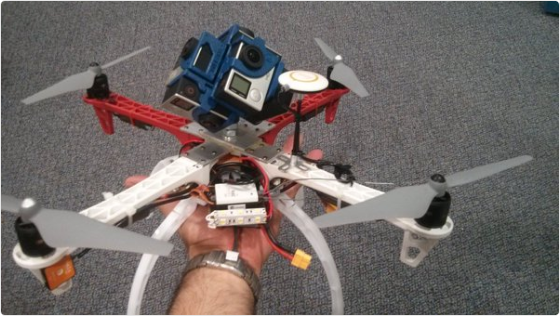
Custom Drone Build w/ 360 Camera Prezi Here
Contextual Essay
Looking at Drones was something I initially wanted to carry into a Cyber cultural extension from their agricultural usage. I wanted to link them to human capacity and challenge the speculative narratives they carried within a local context of my hometown in relatively small rural area. General awareness of their emergence was little and therefore creating a disadvantaged implementation into the corporate sector to perhaps improve a fast-changing technological shift, especially in government workspaces.
As an aim or goal for this digital artefact I wanted to explore ways a quadcopter fitted with a 360-degree video camera could address the ways prevalent culverts (or drainage pipes under the roads) could be inspected, observed and surveyed better and most importantly safer for less costing and less time taken to do so. The artefact was to build a custom drone that hasn’t yet been seen or released in the commercial market that would be something the Roads and Maritime Services would consider innovative and consider implementing into their regular workspaces. The drone has been trialled for observation of large bridges, but not the culvert area, which is where I focussed on. The device isn’t a finished product ready for testing. However, I plan to continue working on it and taking it into future classes, projects and workspaces whilst I continually build on the expertise it’s started giving me. The drone will hover in the air, however the controls are yet to be properly configured which will be done by Rise Above Solutions (an Australian Based Drone expert dealer and service provider) along with a safety inspection in terms of motors, Lipo batteries and propellers. This is so that when the remote control is ready for take-off no unexpected breakages arise leading to an unsafe environment for those around. Once this is completed further testing and flights can be recorded.
Though the artefact isn’t complete, the achievements and overall skillset it’s proven is something that has grabbed my full attention. Firstly, the expertise I’ve gained from this build is amazing and something I’m proud of. YouTube was a great tool that I’ve used and taught myself how to use and build electronics, from soldering wires, to attachments of motors, to battery testing. Then the hardware of the cameras I’ve touched on stitching software and how it can be a timely process, GoPro usage was something I’ve learn new skills in and created other videos of the things that interest me. The lights and switch soldering to the battery was something I learnt from the original soldering tutorials as well as flight expertise, knowing how much thrust etc. to give the drone when wanted to pan or fly forwards, as well as knowing processes into calibrating a remote control, and how this is a pivotal step when buying a universal remote.
Lastly, this project has allowed a whole new aspect of networking. I’ve gained contacts within Rise Above Solutions that I’ll be able to meet with and discuss options for future builds including Rafi Mehdi, the director of the company whose detailed he’d be happy to help in future. Douglas Simkin, UOW tutor, has also detailed of his friends that would be interested in looking at the build whom he’s acquaintances with. Then there’s those I am working with at the RMS, in terms of project managers, Regional Area Managers, and Board members whom I’m giving a presentation to in Bathurst on the 17th June as a progress report on the drone project. All of these are exciting and something I put towards future career prospects. This is due to having thinking about the cybernetic relationship with the drone, the pilot, the camera lens, and the new “bubble” perspective 360 video allows users to think about new possibilities within surveillance.
References
N, Wolchover 2012, What if Humans had Eagle Vision?, Live Science, viewed 18th April 2016, <http://www.livescience.com/18658-humans-eagle-vision.html>
Rothstein, A 2011, Drone Ethnography, Rhizome, Blog, 20 July Viewed 13th April 2016, <http://rhizome.org/editorial/2011/jul/20/drone-ethnography/>>
Suchman, L. 2009, Connections: the double interface and constructing the cyborg body. 1st ed. ebook MIT OpenCourseWare, p.15. viewed 22 April 2016, Available at: <http://mitocw.eia.edu.co/courses/anthropology/21a-850j-the-anthropology-of-cybercultures-spring-2009/assignments/MIT21A_850Js09_sw01.pdf>
Chris Moore, 2016, #dronestories, prezi lecture, DIGC335, University of Wollongong, 3rd May 2016, viewed 5th May 2016, <https://prezi.com/b9fp3pnjfqew/dronestories/?utm_campaign=share&utm_medium=copy>
Chris Moore, 2016, Cybercultures Week Two 2016 (w.2), Prezi lecture, DIGC335, University of Wollongong, 8th March 2016, viewed 24th April 2016, < https://prezi.com/poqmln3hslyh/cybercultures-week-two-2016-w2/>
Small UAV coalition 2014, About us/Current Rules, Small Uav Coalition, viewed April 30th 2016, < http://www.smalluavcoalition.org/>
Fredrick Lardinois 2015, Talking Drones With 3D Robotics CEO Chris Anderson, Techcrunch, Viewed 30th April 2016, < http://techcrunch.com/2015/01/11/talking-drones-with-3drobotics-ceo-chris-anderson/>
Konstantin Kakaes 2015, Drone Regulation – Privacy and Property rights, PDF, New America, Chapter 3, viewed 2nd May 2016, < http://www.iapad.org/wp-content/uploads/2015/07/DronesAndAerialObservation.pdf#page=29>
Street Insider, 2016, 360fly Partners with Livit to Offer First Live Streaming Platform for Mobile Virtual Reality, Street Insider, viewed 1st June 2016, < http://www.streetinsider.com/Press+Releases/360fly+Partners+with+Livit+to+Offer+First+Live+Streaming+Platform+for+Mobile+Virtual+Reality/11417004.html>
Ballesteros, A 2014, DJI F450 Quadcopter Assembly, online video, 30 March, YouTube, viewed April 10th 2016, < https://www.youtube.com/watch?v=3noy4Dhvhx0>
MultiRotors, M 2014, How to Build the DJI F450 Flamwheel Drone With Naza Flight Controller and DT7 Radio, Online Video, 18th April, YouTube, viewed april 12th 2016, < https://www.youtube.com/watch?v=ER2GxMo0X3E>
360fly Support, 360Fly and Livit Team Up to Offer live Streaming of 360 degree video, 360Fly, viewed 1st June 2016, <https://support.360fly.com/hc/en-us/articles/218071267-360fly-and-Livit-team-up-to-offer-live-streaming-of-360-video>
Parrot Mini Drones, Maclane Airborne Night Drone, Parrot.com, viewed 1 June 2016, <http://www.parrot.com/usa/products/minidrones/airborne-night-drone/mcclane/>
Drones & 360 Videos
Link to 360 Degree Drones Prezi
Transcript
Cyberculture can be referred to as the “response to the ubiquitous presence and use of computers and networks for aspects of contemporary social life” for example entertainment. I wanted to link ‘computers’ to a broader extension of what is thought of, in a PC or laptop, to a motherboard of controls to Arduino to robotics, thus drones and their hardware.
Over the last year I’ve built an expertise looking into Drones In Agriculture as well as Production, Consumption and Representation of Drones in China.
This allowed me to then extend the interest into First Person View (FPV) Drone viewing and 360 degree cameras, modding quadcopters for performance and overall extending their immediate and obvious tasks, then their implication to the way the drone is represented to a wider consumer. Initially I set out to study the use of FPV goggles in racing situations and the cybernetic relationship between the craft’s lens and the human eye and then link the research into the Game Cultures class looking at a FPV league at university.
So this is where my investigation began and along the way evolved. The FPV goggles I believed served as an extended lens to the iris to view a particular moment in space that I alluded to a “disembodiment gaze”. photo Iris > Lens
You can’t see those around you at this point without the assistance and view of the drone, and if there is a monitor connected picking up the analogue signal then this further develops this as those around can see you and the view you have, yet you can’t see them. The idea of having complete freedom in FPV goggles to view whatever the drone saw fascinated me, but didn’t satisfy until I came across an FPV race flight that had a 360-degree camera attached, which ultimately left the flight path viewing in complete user control. 360 Degree video has been used for another extension of what I touched on regarding FPV flight.
https://www.youtube.com/watch?v=WOwDxVUyTUY
This drone racing with 360 video adds a whole new element to the displacement of the viewer. It has little alteration to the pilot, however this kind of thinking works its way into the world of invention drone narratives
This idea of viewing spaces without having to physically move, linked nicely with an external project I am working on for the Roads and Maritime services (formally RTA) about the use of drones for observation and surveillance not seen yet in technological trajectory. Drones entered the consumer world without the slightest hint of public awareness and it’s a positive direction for the technological evolution of the device. Building on the extension of the eye, 360 Video Technology has integrated its way onto the drone for a more immersive and natural viewing angle ever.
One particular device that I’ve managed to get my hands on is the 360Heros camera mount, that acts like a human extension of the skull or neck. The user is able to click and drag viewing any part of the footage they desire. This extends the original narrative of the commercialization of the drone in organisations.
https://www.youtube.com/watch?v=by8ob_oGbdk
Traditionally, the surveillance of the inside quality of a prevalent culvert has required a physical exploration by an employee to get inside and make observations. These areas are often wet, dirty/muddy, unhygienic in terms of syringes as well as infested with bugs, spiders and other unwanted inhabitants. By sending a Drone inside this area, the user is able to control a constant altitude as well as 360 degree swivel option to view all parts of the inside of the pipe.
Something that’s facilitated the use of 360 degree cameras as a consumer friendly entity, is the idea of the drone casting narratives from its invention to present day availability. Chris Moore delivered a lecture #dronestories that discussed the idea that all drone types, whether they be quadcopters I’m dealing with, RC Model planes or UAVs (unmanned aerial vehicles), all devices have a story that dictates a stigmatic association and comfort in space. The Internet is already a widely accepted use of technology, no one has any problems with it but it hasn’t always been the case. Connections can be drawn with how our obsessive use of the internet is linked to why we as a participatory culture are subconsciously becoming a drone enthusiast society. If we look at the drones characteristics and then we look at current technological consumption, we can see the definitive overlap.
Drone Technology characteristics
- UAV
- Geographic information systems
- Surveillance
- Sousveillance – that is an activity is recorded by a participant in that activity.
- Mediation platform – its own experience
Now if we look at the consumer side of technological consumption we see
- Mapping programs (I a likened to GPS)
- Location aware pocket software ( iphone > then using location services)
- Public sourced media data base (YouTube is the big one for footage)
- Apps and algorithms that navigate (this link from Facebook can be used in software such as A.R. Free Flight 2.0)
Therefore, these characteristics are both key components that make up the drone, from which were already in existence before the commercial drone was released. So I’m of the belief that the technological make up isn’t where the anxiety lies, it’s what people are doing with the devices which calls for the urgency for regulation separate and exclusive. Discussed heavily by Adam Rothstein that I would like to draw into using Chris Anderson’s idea that the drone is at the level of a 1970s personal computer. The computer and later the internet become socially and commercially a phenomenon that is something we’re all connected to and have access to. I like the idea that the drone will merge its way through regulation and defeat the mythos accompanying all new technology.
Drones come with a certain technological mythos, a speculative narrative that is slowly being integrated into commercial uses and the features of 360 video is something I believe is helping the changing speculation regarding them. 360 video gives complete control to the viewer on where they want to look spatially within the video experience. Mount the camera to a drone and all of a sudden new perspectives and narratives are drawn, and possibilities both human and technological are seen.
The FPV research from game cultures had its own study path, which lead me into areas of design, modification and expansion. This facilitated my own drone build to which I could study and aim for in a drone that carried another new camera narrative in 360-degree video. Not only has the viewer now have access to complete freedom with the video viewing position, they now have an added perspective from a drone. The extension from the human and in particular the eye, lead me into some slightly left field research but I found interesting none-the-less.
Man’s link to human enhancement is through tech with animal characteristics and in particular the 360 degree camera attached to a drone presents an eagle like advantage. The idea is that an FPV goggle mount is fixed with a 360 camera, the human has ultimately enhanced themselves based on animal, specifically predator, advantages. Predatory eyes in front for perceptual jumping, the idea is that aggressive immanence only requires a forward view. Then if you think about the prey collection of creature’s eye sight, they’re designed to sense the prey 180 degrees around them with the 90-degree forward view access by constant movement.
This quote debates the idea of humans being fitted with eagle vision, however it clearly resembles that perspective of a drone attached with a 360-degree camera.
With an eagles 20/5 (four to five times greater than human) vision also have nearly double the field of view. With our eyes angled 30 degrees away from the midline of our faces like an eagle’s, we would see almost all the way behind our heads with a 340-degree visual field (compared to normal humans’ 180 degree field); this would confer a clear advantage in hunting and self-defense.”
(http://www.livescience.com/18658-humans-eagle-vision.html)
This exploration has added a cybernetic comparison to human enhancement as an extension of our current capacity. For this to be even more cyborg-like, I think a live 360-degree feed directly to a monitor or screen that the user could control in real time would be the closest thing to an eagle eye transplant.
So, where to now? I’m going to continue the exploration into the 360-degree video unboxing as I’ve been building a knowledge base from various sources including YouTube tutorials, forums such as reddit and whirlpool as well as trial and error, all while filming “Stark” style videos that showcase the complete start from scratch approach I have. I hope to have a 360-degree video from the 6 GoPros and mount, and If time permits, I’ll attach it to the drone and do some tests there. The drone will be ready for when the 360 video works, otherwise I’ll build the camera expertise alone.
N Wolchover 2012, What if Humans had Eagle Vision?, Live Science, viewed 18th April 2016, <http://www.livescience.com/18658-humans-eagle-vision.html>
Rothstein, A 2011, Drone Ethnography, Rhizome, Blog, 20 July Viewed 13th April 2016, <http://rhizome.org/editorial/2011/jul/20/drone-ethnography/>
Suchman, L. 2009, Connections: the double interface and constructing the cyborg body. 1st ed. ebook MIT OpenCourseWare, p.15. viewed 22 April 2016, Available at: <http://mitocw.eia.edu.co/courses/anthropology/21a-850j-the-anthropology-of-cybercultures-spring-2009/assignments/MIT21A_850Js09_sw01.pdf>
Chris Moore, 2016, #dronestories, prezi lecture, DIGC335, University of Wollongong, 3rd May 2016, viewed 5th May 2016, <https://prezi.com/b9fp3pnjfqew/dronestories/?utm_campaign=share&utm_medium=copy>
Chris Moore, 2016, Cybercultures Week Two 2016 (w.2), Prezi lecture, DIGC335, University of Wollongong, 8th March 2016, viewed 24th April 2016, < https://prezi.com/poqmln3hslyh/cybercultures-week-two-2016-w2/>
Small UAV coalition 2014, About us/Current Rules, Small Uav Coalition, viewed April 30th 2016, < http://www.smalluavcoalition.org/>
Fredrick Lardinois 2015, Talking Drones With 3D Robotics CEO Chris Anderson, Techcrunch, Viewed 30th April 2016, < http://techcrunch.com/2015/01/11/talking-drones-with-3drobotics-ceo-chris-anderson/>
Konstantin Kakaes 2015, Drone Regulation – Privacy and Property rights, PDF, New America, Chapter 3, viewed 2nd May 2016, < http://www.iapad.org/wp-content/uploads/2015/07/DronesAndAerialObservation.pdf#page=29>
Culvert Inspection
Traditionally, the surveillance of the inside quality of a prevalent culvert has required a physical exploration by an employee to get inside a make observations. These areas are often wet, dirty/muddy, unhygienic in terms of syringes as well as infested with bugs, spiders and other unwanted inhabitants. By sending a Drone inside this area, the user is able to control a constant altitude as well as 360 degree swivel option to view all parts of the inside of the pipe. Drones today are no larger than 1m x 1m in size, and continue to go smaller to the user’s needs, which is ideal for a space such as these. As the quality of the drone moves up, so does the accessibility of useful functions such as maneuverability of the camera separate to the drone itself, which allows a view of the top of the pipe to be captured and inspected. This eliminates health and safety hazards with all kinds of materials dropping from the roof of the pipe. Being inside a condensed space also provides a shelter from the elements of weather that affect some budget drones (such as wind speed affecting stabilisation or stationary ability of the drone, which allows easier piloting and better quality footage.
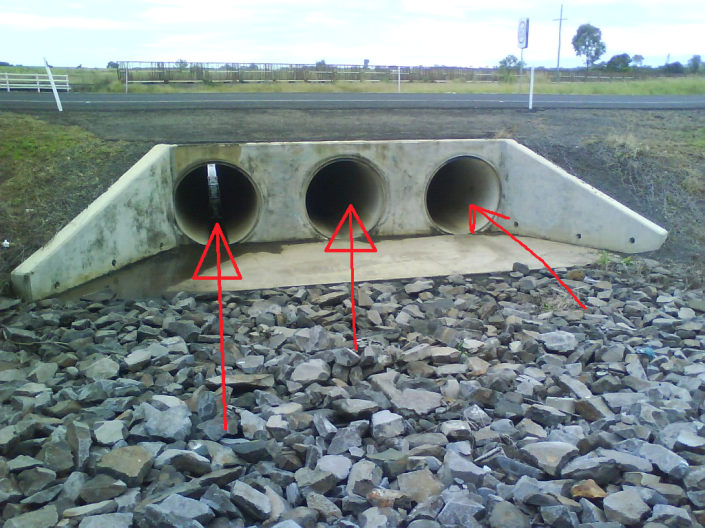
These simple drawings show how the drone could be piloted into the culvert from a distance without the need for the inspections requiring people to physically go inside.
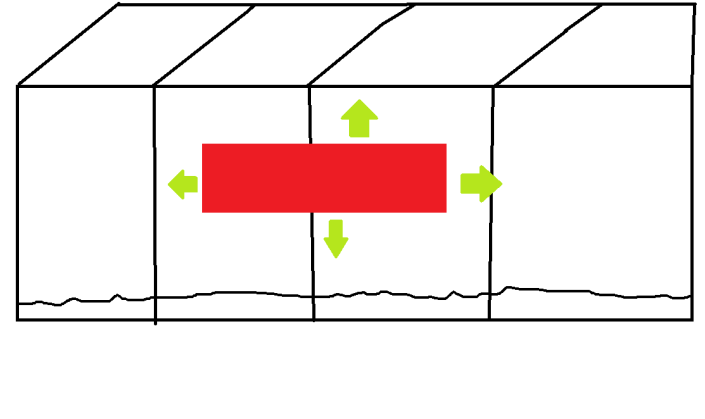
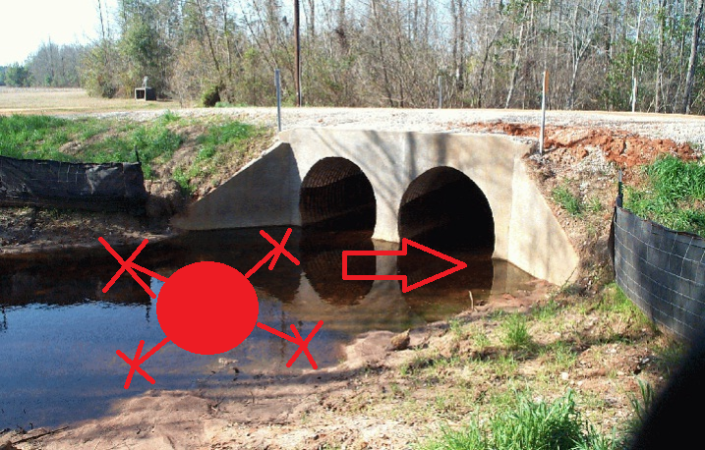
This shows the materials (water, dirt) that are often present when workers have to climb in and inspect the culvert. As shown, the drone hovers above this, which improves on current ideas of remote controlled devices such as cars that have trouble getting through if its thick.
The drone is shown above it from the view of the inside of a square culvert, showing the potential to capture footage and photos from al views depending on the camera angle and size of the drone in comparison to the area space. If an accurate scale can be modelled from the view of the drone (for example height and length of the damage within the pipe) then the amount of resources allocated to its repair can be fine-tuned to improve sustainability of materials used (eg. Supports).
An overview of what I need includes:
- A 360 degree device for filming (this has to include the mount & cameras) – this will then be run through some kind of Software to analyse and utilize “click and drag” 360 degree viewing. I’ve found the software package that comes with the cameras and has excellent reviews, to which I’ve already started watching the tutorials to get an idea on how to convert footage to data useful for direction.
This could be from a company in America Called 360Heros:
http://shop.360heros.com/PRO6L-360-VIDEO-360-HEROS-p/pro6l.htm
– Software 360CAMMAN-V2
– H3Pro6N 360 Plug-n-Play™ Holder
– 6 Go pros (Purchased Separately)
Eg.
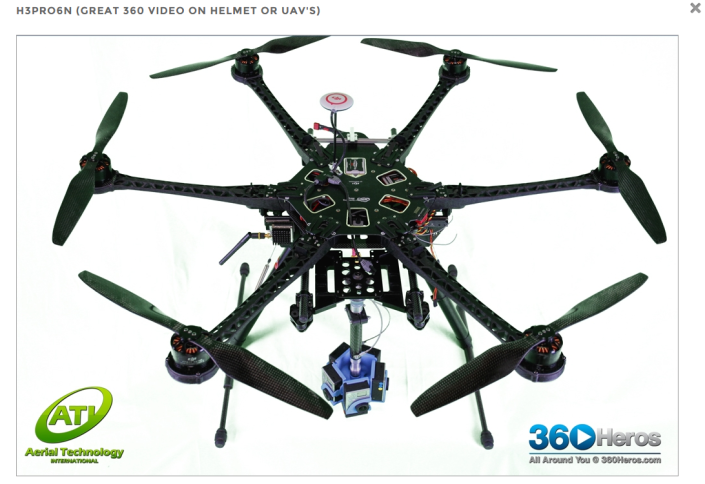
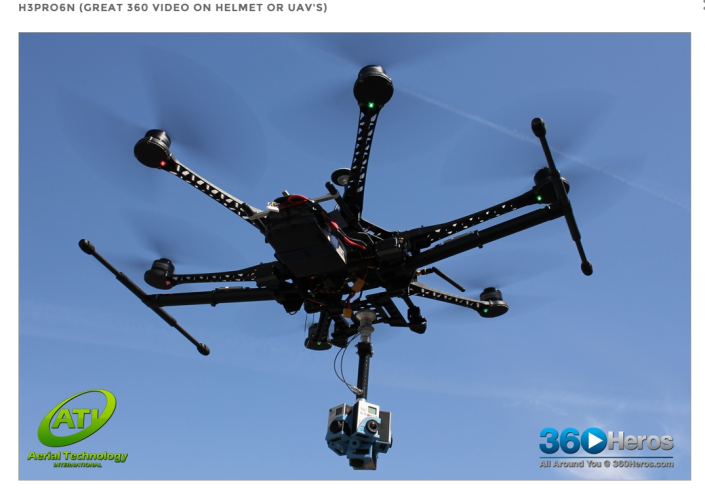
A flashlight option – I’ve included what I’ve found, but I thought you might have some ideas on a small and powerful light attachment that could possibly be integrated into the body of the drone. These being a singular bulb instead of say a flashlight that will add weight and size to the drone. If you look at the http://www.parrot.com/au/products/airborne-night-drone/ parrot night drone it has small LED lights. I was thinking something similar but more exposed perhaps all the way around the drone. So getting up to 10 and place them in spare space around the drone.
- The drone itself – being small enough in size yet still the ability to attach the components needed for the research. The smallest available would be ideal, and culvert sizes can be seen in a second attachment
The aerial drone technology solution must meet the following requirements:
- able to operate within an unlighted enclosed space of width 0.5m wide by 0.2m deep by 30m long.
- capture visual images of culvert cell soffit, walls and base slab to a resolution which would allow 0.2mm wide concrete cracks to be identified
- capture visual images of culvert cell soffit, walls and base slab to a resolution which would allow 0.2mm wide concrete cracks to be identified
- able to inspect multiple (up to 20) bridge size culverts per day (without the need to return to an office/depot for battery charging during the day)
- Procure aerial drone technology for a field test trial.
- Perform field test trial of aerial drone technology solution.
- Record observations and evaluate performance against objectives
Quadcopter Narrative: Perspective
Drones entered the consumer world without the slightest hint of public awareness and its a positive direction for the technological evolution of the device. Building on the extension of the eye, 360 Video Technology has integrated its way onto the drone for a more immersive and natural viewing angle ever. One particular device that I’ve managed to get my hands on is the 360Heros camera mount, that acts like a human extension of the skull or neck. The user is able to click and drag viewing any part of the footage they desire. This extends the original narrative of the commercialization of the drone in organisations.
I’ve designed and built a drone for the RMS (Roads and Maritime Services) that is using both the drone technology available, as well as the 360 heros camera mount that will hopefully take away the human hazards of inspecting culverts in roads. The drone doesn’t serve this extension of human capacity for just the services of entertainment and perspective, but for resources and safety. Instead of crawling through drainage pipes these inspections can be performed by one flight through the culvert with a 360 camera, that allow as many views as needed with 360 degree immersion.
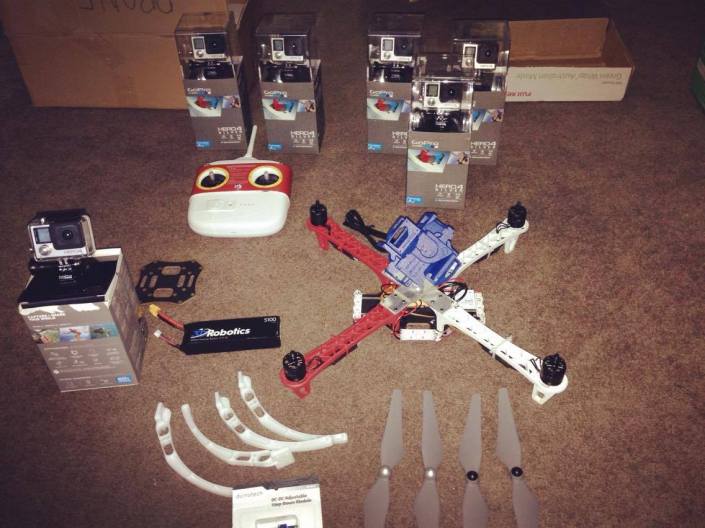
360 Degree video has been used for another extension of what I touched on regarded FPV flight. This drone racing with 360 video adds a whole new element to the displacement of the viewer. It has little alteration to the pilot, however this kind of thinking into the world of invention drone narratives. Much like the car modding community, as a contemporary example, the way drones are being tinkered and constructed in DIY kits allows a whole new perspective into a consumer market.
Drone: Extension of the Term
Drones allow an extension of the human eye from a unique perspective from a controlled camera flight. This referral offers analysis of the bridge between technology and human capacity. I want to explore the nature of the drones lens in cybernetic comparison to the eye, as well as FPV (first Person View) as the entry into intentional narratives drawn by their development. Almost think of the view from a drone as if the operator were inside the drone when thinking FPV flight.
The drone industry started with a public perception of fear and lead to anxieties about military and surveillance use that ultimately restricted policy towards the potential for expansion. 3D Robotics CEO has detailed the rising of a small online community “Small UAV Coalition” that according to their website aims to challenge current legislation that restricts the development for enthusiasts to suit their drone needs. They’ve impressively gained the support and representation from Amazon Prime Air, DJI, Google[x], GoPro, Parrot, and 3DR
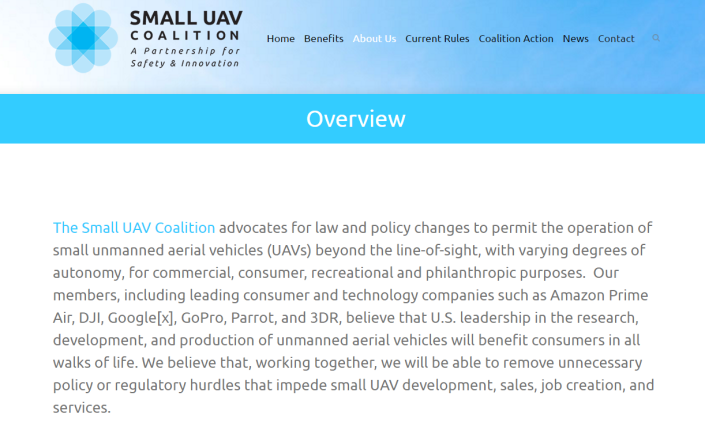
(http://www.smalluavcoalition.org/overview/)
He details how drones have taken a dramatic shift in the last 3 years in terms of their trajectory and narrative. Chris hopes that in 5 years the intentional narratives of drones will be predominately commercial. The idea that agriculture, delivery, humanitarian and construction will be required to have a drone on site to keep ahead of the advancing fields. Personally, these small communities such as “Small UAV coalition” are major steps in the development of my own expertise with events such as Hackergong gaining attention and interest from a wider community that expand the idea of mods to drone applications.
FPV flight falls under this threat, as the current restrictions on goggles don’t allow the entertainments such as FPV racing or even controlled flights with the technology in Australia. Communities are realising their strength in numbers however getting around the regulations with the terminology of their practices.

(http://mongrelgear.com.au/legalities.html)
The development of DJI’s Phantom 4 “sports mode” is in my opinion the showcase of the rapid development from the drone being a military class to consumer by allowing users to have more freedom with the control and almost being a direct link into FPV flight with the monitor, and hopefully later the goggles.
Cybernetics, Cyborgs or Just Drones?
Unmanned aerial vehicles, quad-copters or drones whatever you like to refer to them as offer a unique perspective into a space with a camera lens controlled by you. This referral to an extension of the human eye offers the analysis of these machines as a bridge to technology and human capacity. The use of FPV goggles allows the pilot to have an immersed view of the drones lens as if they were inside the device, and control its flight path without having to watch the device itself.
As a cyber-cultures principle of embodiment unnecessary to being human, this sensation of flying what I believe the closest thing to a spaceship, adds to my intention to exploring the drone as an extension to the human eye. Throughout my investigation I want to uncover the categories in which are linked to the drone/human assessment, how drones are increasingly being used for tools of observation and surveillance (usually or previously done by the human eye) and the use of FPV (first person view) goggles in comparison with a screen based view. The limitations and areas of design and expansion to this technology and how open source models involve a community linking to major corporations. For example, FPV racing popularity has seen the release of what used to be a strict aerial photography device upgraded to posses a “sports mode” in the DJI Phantom 4. This is explained to be ideal for the beginner drone enthusiast who is looking at improving his aerial control and skills to eventually move onto FPV piloting.
Through my investigation of drones, I’d like to cover some glitching and problems associated with FPV flight, including discussions I’ve noted from peers including range, camera/goggle dropout and the limitations with users needing prescriptions for their visions as well as motion sickness queries.